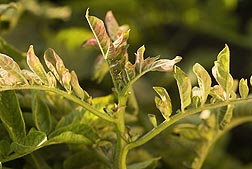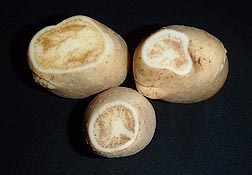Multi-Pronged Fight Against Zebra Chip Disease in Potatoes
|
|
Thanks to the investigations of scientists-turned-detectives, potato growers in the western United States and abroad now know the identities of the pathogen and insect responsible for outbreaks of the costly tuber disease known as “zebra chip.”
So named for the dark stripes it forms inside afflicted tubers when cut and fried to make chips or cooked at high temperatures for other dishes, zebra chip has caused millions of dollars in production and processing losses since its first reported U.S. occurrence in potato fields near McAllen and Pearsall, Texas, in 2000. The disease, whose above-ground symptoms include necrosis and purplish, upward-curling leaves, among others, has since been reported in several other states (California, Nevada, Kansas, Nebraska, New Mexico, Colorado, Wyoming, Washington, Oregon, and Idaho), Mexico, parts of Central America, and New Zealand.
Intensive collaborative research by university, industry, and government scientists, including teams from three ARS laboratories—the Yakima Agricultural Research Laboratory (YARL) in Wapato, Washington; the Vegetable and Forage Crops Research Laboratory (VFCRL) in Prosser, Washington; and the Beneficial Insects Research Unit (BIRU) in Weslaco, Texas—narrowed the list of likely suspects to a fastidious (nonculturable) bacterium, Candidatus Liberibacter solanacearum, and the potato psyllid,Bactericera cockerelli, as its insect accomplice or “vector.” (See “Bacterium Identified as Prime Suspect in Zebra Chip Case,” Agricultural Research, October 2009, p. 22.)
The discovery is helping growers in affected regions improve their timing and use of insecticide sprays to prevent psyllids from feeding on and infecting potato crops with the zebra chip bacterium (hereafter “Liberibacter”). Longer term, researchers aim to recommend alternative controls for use in integrated approaches to managing the disease-spreading pest. Besides savings on insecticide use, other benefits of integrated pest management (IPM) include preservation of beneficial insects, prevention of secondary pests, and decreased risk of insecticide resistance developing in psyllid populations. Genetic resistance in plants to the pathogen or host is yet another benefit.
|
|
The “A-Team” Responds
Zebra chip is here to stay, so providing growers with IPM tools that will fit into their production systems over the long haul is of paramount importance, says YARL entomologist Joe Munyaneza. Since 2005, he’s served on a multidisciplinary team of zebra chip investigators that includes VFCRL plant pathologist Jim Crosslin; BIRU entomologist John Goolsby; and experts from Washington State University-Pullman, the University of California-Riverside (UCR), Texas AgriLife Research-Weslaco, Northwest A&F University-Yangling, China (NAFU), and MAF BioSecurity New Zealand, among others.
Even as basic lab research on the psyllid-Liberibacter association continues, scientists are hard at work in the field evaluating biobased products for potential use in devising IPM strategies to minimize the incidence of zebra chip. Other fieldwork includes close monitoring of psyllid populations for the presence of Liberibacter.
“John Goolsby and I have started the third year of weekly testing of psyllids collected in Texas, Nebraska, and Kansas for the bacterium,” says Crosslin. “This is to see if the incidence of the bacterium in psyllids moving into a potato-growing area can be used to predict the potential for development of zebra chip disease in the crop.”
Kaolin Combat
Over the past year, for example, an ARS-university team has conducted lab and field tests of a commercially available technology known as “kaolin particle film.” Kaolin is a nontoxic, reflective clay-based powder that can be mixed with water and sprayed onto plant leaves. Upon drying, it forms a protective coat, or barrier, that disrupts feeding and egg laying by certain insects, as well as infection by some pathogens. The technology has also been shown to reduce moisture loss, heat stress, and sunburn damage to treated fruits, such as apples.
|
|
Though kaolin is effective against mites, citrus root weevils, pear psyllids, and other sap-sucking insect pests, until now it hasn’t been tried on potato psyllids, note Munyaneza and colleagues in a paper published in 2011 in Pest Management Science.
To evaluate the particle film, the team conducted a series of choice/no-choice lab and field experiments using special insect cages. For free-choice experiments, adult psyllids were allowed to choose between treated and untreated tomato plants. For no-choice experiments, they had no alternative but to land on treated plants. With this experimental design, the researchers could observe the pest’s responses and collect data on what effect the kaolin had on feeding and egg laying.
Of particular interest was the treatment’s repellency upon contact, since potato psyllids can transmit Liberibacter within an hour of probing host plants for sap. Indeed, it only takes one feeding psyllid to infect a plant with the disease, notes Munyaneza.
While the psyllids did in fact land on kaolin-treated plants (when given no choice but to do so), they spent less time feeding, and females deposited fewer eggs, than did the psyllids that were allowed to visit untreated plants.
“Our data indicate potential for kaolin particle film as a repellent for landing and a barrier to oviposition [egg laying] and may prove to be an economically viable and environmentally sound component of an integrated approach for control of potato psyllids and related pests,” write Munyaneza and coauthors Tong-Xian Liu (NAFU), Linian Peng (Plant Protection Station of Sichuan, China), and John Trumble (UCR).
Building a Biobased Arsenal
In another project, the team, joined by two other NAFU scientists—Xiangbing Yang and Yong-Mei Zhang—compared the repellency of four commercial biorational insecticides, whose active ingredients ranged from natural plant extracts to plant-essential oils and mineral oil.
As with the kaolin study, the researchers conducted choice/no-choice experiments to assess what effect the biorational insecticides had on psyllid feeding and egg laying. The results, reported in the journal Crop Protection, show that all four products were repellent to the pests. Three of the products—SunSpray, BugOil, and Requiem—repelled 77-94 percent of psyllids when sprayed onto plants leaves. The fourth treatment, MOI-201, deterred 47 percent of them.
SunSpray, containing mineral oil, was the most repellent, deterring 94 percent of psyllids. Additionally, no psyllid eggs were found on SunSpray-treated plants. BugOil, which contained plant essential oils, had the longest residual activity, repelling 50 percent after 7 days, the scientists report.
Calling on Friendly Fungi
On another front, a team led by YARL entomologist Lerry Lacey (retired) evaluated commercial biopesticide formulations containing spores of the insect-killing fungi Metarhizium anisopliae strain F52 and Isaria fumosorosea (PFR-97).
In 2009 and 2010 field trials in Weslaco, Texas, applications of F52 reduced the number of psyllid eggs and nymphs (an immature stage) by 45-67 percent, rates comparable to those for the insecticide abamectin (63 percent). Similar reductions were observed with PFR-97. The fungal treatments also reduced damage to treated plants and diminished the severity of zebra chip symptoms in tubers.
Lacey and coinvestigators Munyaneza, Liu, Goolsby, David Horton (YARL), and Jeremy Buchman (formerly ARS) published a paper on the work in the journal Biological Control in 2011.
Resistance: A Cornerstone Defense
The foundation of IPM programs is genetic resistance, and an intensive search is under way to locate the trait in currently produced potato varieties, including collections maintained by ARS’s Small Grains and Potato Germplasm Research Unit in Aberdeen, Idaho. There, ARS scientists Rich Novy and Jonathan Whitworth, along with Juan Manuel Alvarez (University of Idaho), identified several potato breeding clones with resistances to aphids, Colorado potato beetle, and wireworm.
“The many insect resistances in this germplasm made it a good candidate for potential psyllid resistance as well,” explains Novy. UCR collaborators John Trumble and Casey Butler screened the germplasm and observed that resistance was present and was expressed as reduced occurrence and duration of psyllid probing (feeding) and decreased resting.
Use of a procedure known as “Taqman-based real-time polymerase chain reaction” confirmed reduced levels of Liberibacter in the germplasm after feeding by Liberibacter-infected psyllids. While several psyllid-resistant potato clones showed reduced Liberibacter infection, one appeared resistant to the bacterium despite having no apparent psyllid resistance. “This observation suggests that resistance to Liberibacter, and not just to the psyllid vector, may also be contributing to reduced Liberibacter infection,” says Novy.
Scientists caution that further research and replication of results are needed before grower recommendations can be made. But the studies thus far have revealed promising leads towards waging a war that could turn the tables on the tuber disease and its insect accomplice.—By Jan Suszkiw, Agricultural Research Service Information Staff.
This research is part of Crop Protection and Quarantine, an ARS national program (#304) described at www.nps.ars.usda.gov.
To reach scientists featured in this article, contact Jan Suszkiw, USDA-ARS Information Staff, 5601 Sunnyside Ave., Beltsville, MD 20705-5129; (301) 504-1630.
"Multi-Pronged Fight Against Zebra Chip Disease in Potatoes" was published in the February 2012 issue of Agricultural Research magazine.









